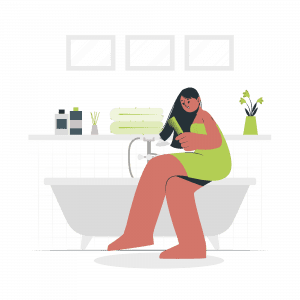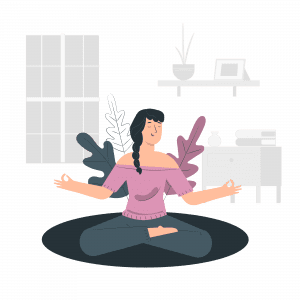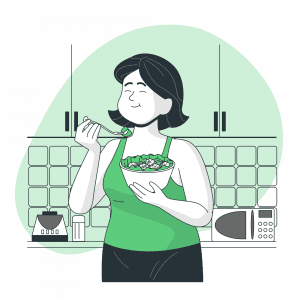Introduction
Welcome to Self-Care Sunday, your weekly opportunity to step back and indulge in some much-deserved personal time. In our fast-paced lives, carving out moments for self-care is crucial for maintaining balance and wellness. This guide will introduce you to seven relaxing rituals to transform your Sundays into a sanctuary of serenity and self-love. Each one is tailored to help you unwind, offering a blend of tranquility and rejuvenation. From the calming flow of yoga to the reflective practice of journaling, these rituals are more than just activities; they’re pathways to a more relaxed, centered you. Let’s dive into creating a Sunday that’s all about caring for you.
Ritual 1: Luxurious Bath Time

Transforming your ordinary bath into a luxurious spa-like experience is the first step in your Self-Care Sunday journey. A warm, soothing bath isn’t just about cleanliness; it’s a sanctuary where you can unwind, relax your muscles, and let go of the week’s stresses.
Creating Your Spa-Like Atmosphere:
Begin by setting the mood. Light some scented candles or dim the lights to create a tranquil environment. The soft, flickering light helps calm the mind and eases you into a relaxed state.
Choosing the Right Additives:
Incorporate elements like Epsom salts, essential oils, or bubble bath for added relaxation and skin nourishment. Epsom salts are known for their muscle-relaxing properties, while essential oils like lavender or chamomile can enhance the calming effect with their soothing aromas.
The Power of Sound and Music:
Consider adding a background of gentle, soothing music or nature sounds. The right auditory experience can transport you from your bathroom to a serene forest or peaceful beach, augmenting the relaxing effects of your bath.
Mindful Bathing:
As you sink into the warm water, close your eyes and take deep, slow breaths. This is an opportunity to practice mindfulness, focusing on the sensation of warmth enveloping your body, the soft sounds around you, and the delicate fragrances that fill the air. Allow yourself to be present in this moment, letting thoughts and worries dissolve in the water.
Hydrate and Nourish:
Don’t forget to hydrate – keep a glass of cool water nearby to sip on. Hydration is key, especially in the warmth of the bath. You might also want to apply a face mask or hair treatment while you soak, adding an extra layer of pampering to your bath time.
Post-Bath Care:
Once you step out of the bath, wrap yourself in a soft towel or robe. Apply your favorite moisturizer to lock in the skin’s moisture, leaving it feeling soft and refreshed.
This ritual is more than just a bath; it’s a multi-sensory experience that rejuvenates not only your body but also your mind and spirit. It sets the tone for a relaxing and restorative Self-Care Sunday.
Ritual 2: Digital Detox

Our second ritual for Self-Care Sunday is the Digital Detox. In a world where we are constantly bombarded with digital notifications and screen time, unplugging can have a remarkably rejuvenating effect on your mind and spirit. This ritual is about consciously disconnecting from digital devices to reconnect with yourself and your surroundings.
The Need for a Digital Break:
Our daily overexposure to screens can lead to digital fatigue, impacting our sleep, attention span, and even our mental health. A digital detox, even for just a day, can reduce stress, improve focus, and enhance your overall sense of well-being.
Setting Up for Success:
Begin your digital detox by informing friends or family if necessary, so they know you won’t be immediately reachable. Then, turn off non-essential devices and notifications. If completely disconnecting isn’t feasible, set specific ‘check-in’ times for essential communications only.
Filling the Digital Void:
Plan activities that you enjoy and that engage you in the physical world. This could be reading a book, practicing a hobby, or simply spending time in nature. The idea is to find joy and fulfillment away from the digital sphere.
Mindfulness and Presence:
Use this time to practice mindfulness. Be fully present in each activity, whether you’re taking a leisurely walk, preparing a meal, or spending time with loved ones. Notice the details around you, the sensations, and the experience of being unplugged.
Reflect on the Experience:
At the end of the day, reflect on your digital detox. Did you notice a difference in how you felt, thought, or interacted with others? Use these insights to assess how you can incorporate regular digital breaks into your routine.
The Digital Detox isn’t about shunning technology altogether but about creating a healthy balance. It’s about reclaiming your time and attention, so you can focus on what truly matters to you.
Ritual 3: Mindful Meditation or Yoga

For the third ritual of Self-Care Sunday, immerse yourself in the grounding practices of mindful meditation or yoga. These practices are not only about physical flexibility or strength; they’re avenues to a deeper sense of inner peace and mental clarity. Research published in the NIH supports their efficacy, revealing that individuals who engaged in regular mindfulness meditation experienced a significant decrease in stress and anxiety.
Embracing Mindful Meditation:
Mindful meditation involves focusing on your breath and being fully present in the moment. It’s about observing your thoughts and feelings without judgment. As a beginner, start with short, five-minute sessions, gradually increasing the time as you feel more comfortable. There are numerous guided meditation apps available to help you start. The key is consistency – even a few minutes daily can make a substantial difference.
Integrating Yoga into Your Routine:
Yoga combines physical postures with controlled breathing and meditation, offering a holistic approach to relaxation and stress relief. Start with basic poses and pay attention to your breath, using it to guide your movements. Yoga is not about perfection but about connecting with your body and breath. Classes are available online or in-person, catering to all levels.
Also Read: 21-Day Yoga Challenge
Physical and Mental Benefits:
Both meditation and yoga are proven to reduce cortisol levels, the body’s stress hormone. They improve concentration, enhance self-awareness, and promote emotional well-being. Additionally, yoga offers the physical benefits of improved balance, flexibility, and strength.
Creating a Sacred Space:
Designate a quiet, comfortable spot in your home for your practice. You might add cushions, candles, or anything else that creates a serene environment. This physical space can then become a symbol of peace and tranquility in your home.
Remember, the goal of mindful meditation and yoga is not to empty your mind or achieve the perfect pose but to develop a deeper connection with yourself. Regular practice can help you approach life with a calmer, more centered perspective, making it an ideal ritual for your self-care toolkit.
Ritual 4: Nourishing Your Body

The fourth ritual of Self-Care Sunday revolves around the theme of nourishment – treating your body to healthy, delicious foods that rejuvenate and energize you from within. It’s about embracing the joy of eating, not just as a necessity, but as an act of self-love and care.
Understanding the Role of Nourishment:
What we eat significantly impacts our physical health, mood, and energy levels. Self-Care Sunday is the perfect opportunity to pay attention to this aspect of self-care by preparing meals that are not only nutritious but also bring you pleasure and satisfaction.
Planning Your Meals:
Start by choosing recipes that appeal to you and provide a balance of nutrients. Consider incorporating fresh, whole foods like fruits, vegetables, lean proteins, and whole grains. If cooking feels daunting, simple yet wholesome meals can be just as nurturing. The key is to focus on quality ingredients that nourish both the body and the soul.
Mindful Eating Practices:
Take this day to practice mindful eating. This means eating slowly, savoring every bite, and truly appreciating the flavors and textures of your food. Pay attention to how the food makes you feel and the signals your body sends about hunger and fullness.
Read Further: How to stop mindless eating?
Hydration is Key:
Don’t forget about staying hydrated. Water is essential for every bodily function, and keeping well-hydrated is a fundamental part of self-care. Infuse your water with slices of fruits or herbs like mint or basil for an extra refreshing twist.
Indulge in Moderation:
Allow yourself a treat if you desire. Self-care isn’t about strict restrictions; it’s about balance and listening to what your body needs and wants.
This ritual isn’t just about the act of eating; it’s a holistic approach to nourishing yourself in a way that respects and honors your body’s needs. It’s an opportunity to reset your relationship with food and celebrate its role in your overall well-being.
Ritual 5: Nature Connection

The fifth Self-Care Sunday ritual is all about reconnecting with nature. Immersing yourself in the natural world is a profound way to de-stress, rejuvenate, and gain a fresh perspective. Nature’s calming effect is a powerful antidote to the hustle and bustle of everyday life, providing a sense of peace and grounding.
Benefits of Time Spent in Nature:
Spending time outdoors has numerous benefits for both physical and mental health. It can reduce feelings of stress and anxiety, improve mood, enhance creativity, and even boost your immune system. The serenity and beauty of nature have a naturally soothing effect that’s hard to replicate in an indoor environment.
Ways to Connect with Nature:
-
-
- Take a Walk or Hike: Explore a local park, trail, or nature reserve. The act of walking, combined with the sensory experience of being in nature, can be incredibly restorative.
- Gardening: Whether it’s tending to houseplants or a garden, interacting with plants is a rewarding way to connect with nature.
- Outdoor Meditation or Yoga: Practice meditation or yoga in your backyard, a park, or by the beach. The natural sounds and fresh air can enhance your experience.
- Bird Watching or Wildlife Observation: Simply observing the flora and fauna around you can be a peaceful and fascinating activity.
- Picnics: Enjoying a meal outdoors is a delightful way to combine nourishing your body with enjoying the natural world.
-
Mindful Appreciation:
While you’re outside, try to practice mindfulness. Pay attention to the sights, sounds, and smells around you. Notice the texture of the ground beneath your feet, the patterns of leaves on trees, the movement of clouds, or the feel of the breeze on your skin.
Balancing Indoor and Outdoor Life:
Even if you live in an urban environment or have a busy schedule, find small ways to integrate nature into your life. It could be as simple as sitting by a window with a view of trees or keeping a collection of plants in your living space.
Embracing nature is about more than just physical health; it’s about feeling a deeper connection to the world around you and gaining a sense of peace and balance in your life. This ritual is an invitation to step outside and let nature’s beauty rejuvenate your spirit.
Ritual 6: Indulge in a Hobby or Creative Activity

The sixth ritual for your Self-Care Sunday is to indulge in a hobby or a creative activity. This is about setting aside time for activities that bring you joy, spark your creativity, and provide a satisfying escape from the day-to-day routine. Engaging in hobbies and creative pursuits is not only enjoyable but also beneficial for your mental and emotional well-being.
The Therapeutic Power of Creative Activities:
Creative pursuits, whether artistic, musical, crafting, writing, or any other form, are deeply therapeutic. They offer a form of self-expression, a way to channel emotions, and an opportunity for self-discovery. The process of creating something can be just as rewarding as the end result.
Choosing Your Activity:
-
-
- Rediscover an Old Hobby: Revisit hobbies that you may have enjoyed in the past but haven’t had the time for recently.
- Explore New Interests: Be open to trying something new that has piqued your interest. It could be painting, knitting, gardening, DIY home projects, cooking a new recipe, or learning a musical instrument.
- Make It Enjoyable: The goal is to find pleasure in the activity without any pressure to be perfect. Enjoy the process of learning and creating.
-
Setting the Scene:
Create a dedicated space for your hobby or activity. Having a special area, even if it’s just a corner of a room or a desk, can make your practice more enjoyable and help you get into a creative mindset.
Benefits of Regular Engagement:
Regularly spending time on your hobby can improve your mood, reduce stress, and provide a sense of accomplishment. It also offers a break from digital screens and the busy pace of life, allowing you to focus on something purely enjoyable.
Sharing Your Passion:
Consider sharing your hobby or creative projects with others. This can be a great way to connect with like-minded individuals, gain inspiration, and even motivate others to explore their creativity.
This ritual is a celebration of your interests and talents. It’s a reminder to make time for things that make you happy and bring out your creative side. By incorporating a hobby or creative activity into your Self-Care Sunday, you are giving yourself permission to relax and immerse in the joy of creation.
Ritual 7: Reflective Journaling or Reading

The final ritual for your Self-Care Sunday centers around reflective journaling or immersing yourself in a good book. This ritual is about engaging with your thoughts and emotions, or losing yourself in the world of words, stories, and ideas. It’s a peaceful and introspective way to conclude your day of self-care.
Reflective Journaling:
Journaling is a powerful tool for self-reflection and mental clarity. It allows you to articulate thoughts, feelings, and experiences, providing insight into your inner world.
-
-
- Start or End Your Day with Writing: Dedicate time either in the morning to set intentions for the day or in the evening to reflect on what transpired.
- No Rules, Just Write: Your journal doesn’t have to be structured or perfect. Let your thoughts flow freely on the page.
- Gratitude Writing: Consider including things you’re grateful for in your journal. This practice can shift your mindset and increase positivity.
- Reflect on Your Growth: Use your journal to reflect on how you’ve grown and what you’ve learned from the self-care rituals you’ve practiced.
-
Reading:
Diving into a good book can transport you to different worlds and offer a break from reality. Reading not only provides relaxation but also stimulates your imagination and can even improve empathy.
-
-
- Choose Books That Interest You: Whether it’s fiction, non-fiction, poetry, or self-help, pick a book that captivates you.
- Create a Cozy Reading Nook: Having a comfortable space dedicated to reading can enhance your experience. A cozy chair with good lighting and maybe a cup of tea can create the perfect reading atmosphere.
- Digital or Physical Books: Whether you prefer a traditional book or a digital reader, the key is to find joy and comfort in the act of reading.
-
Benefits of Journaling and Reading:
Both activities offer a peaceful retreat for your mind. They can help reduce stress, improve cognitive function, and promote empathy and understanding. These practices encourage a deeper connection with yourself and the world around you.
Concluding your Self-Care Sunday with reflective journaling or reading is a wonderful way to center yourself and prepare for the week ahead. It allows you to gather your thoughts, celebrate your achievements, and relax in the world of literature.
Conclusion
As we wrap up our journey through the seven rituals of Self-Care Sunday, remember that each of these practices is a step towards a more balanced, fulfilled, and serene life. These rituals are more than just activities; they’re pathways to rejuvenate your mind, body, and soul, creating a harmonious balance in your hectic life.
Self-care is an essential aspect of living a healthy and happy life. It’s not about indulging once in a while but making a commitment to regularly take time for yourself. By incorporating these rituals into your routine, you’re not only taking care of your well-being but also setting yourself up for greater productivity and a positive mindset in the week ahead.
And for those seeking to integrate these practices into their everyday life seamlessly, Woliba offers a perfect solution. Our platform is designed to help you and your team make self-care a priority. With features that support well-being, track progress, and encourage healthy habits, Woliba is your partner in nurturing a culture of wellness and balance. Let Woliba be your guide in transforming these Self-Care Sunday rituals into a consistent, enjoyable part of your life’s journey. Contact us today!




